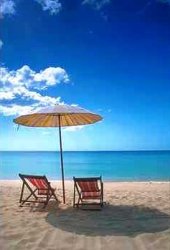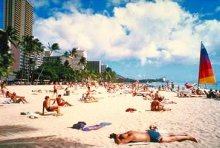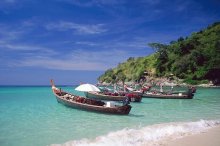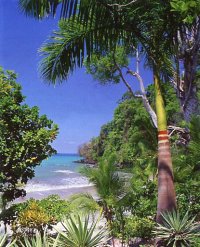|
 Vulnerable
Groups include:- Vulnerable
Groups include:-
-
Fair
skinned people who very often have red or white hair and
blue eyes.
-
Those
persons with certain medical conditions such as albinism,
lots of moles or a previous skin cancer.
-
Those
on certain medications such as tetracyclines or diuretics.
-
People
with certain skin conditions such as psoriasis, eczema
and vitiligo need to take special care when they are in
the sun.
-
The
elderly, babies and young children are particularly sensitive.
General
Precautions
Everyone
should avoid the midday sun, usually from noon until 2pm
(3pm in the tropics).
 Adults
should wear a broad brimmed hat, long sleeved shirts and
sunglasses. Children should wear long sleeved shirts, hats
and high-factor waterproof sunscreen. Babies under 9 months
should be kept out of direct sunlight. Adults
should wear a broad brimmed hat, long sleeved shirts and
sunglasses. Children should wear long sleeved shirts, hats
and high-factor waterproof sunscreen. Babies under 9 months
should be kept out of direct sunlight.
Never
lie in the sun to dry off after swimming, the skin will
burn in a matter of minutes.
High
altitude climbers etc. should wear a hat with a neck cover
and sunglasses with nose shields and blinker side pieces.
Wear
cotton fabrics next to the skin, they are cooler. Avoid
loose weave fabrics that allow penetration of the sun's rays.
 Sun
Factor Preparations Sun
Factor Preparations
Sun factor preparations work by reducing or blocking the effects
of sunlight allowing a person to stay in the sun longer. Everyone
who intends exposing themselves to direct sunlight should
consider using a preparation with an appropriate Sun Protection
Factor.
These
absorb ultraviolet B (UVB) and to a lesser extent ultraviolet
A (UVA).
The Sun
Protection Factor (SPF) refers to the protection against UVB
and will be marked on the outside of the container. Factors
range from 2 to as high as 50.
 With
no protection, most people's skin will start to burn after
10 minutes exposure to the sun. The sun protection factor
allows you sunbathe longer in safety without burning e.g.
An SPF 8 allows approximately 8 times longer sun exposure,
an SPF 15 allows 15 times longer etc. With
no protection, most people's skin will start to burn after
10 minutes exposure to the sun. The sun protection factor
allows you sunbathe longer in safety without burning e.g.
An SPF 8 allows approximately 8 times longer sun exposure,
an SPF 15 allows 15 times longer etc.
There
is now a star system denoting UVA protection where more stars
indicates greater protection.(1 star lowest, 4 stars highest).
Always
re-apply preparations after swimming, even if they are waterproof.
The effectiveness of the protection will always decrease after
immersion in water.
N.B.
The re-application of a given factor does NOT mean that the
protection time is doubled.
 |
To
find out which
Sun Protection Factor
you need:-
|
 |
Sun
Block Preparations
These
preparations are based on zinc oxide or titanium dioxide and
are applied thickly to particularly sensitive areas like the
lips and nose. They block out the sun's harmful rays by forming
a reflective barrier.
They are
particularly useful for persons going to high altitude where
the rays are more intense, and are also popular with certain
sports people such as cricketers who spend long periods in
the sun.
Treatment
of sunburn 
-
Get
the person out of the sun.
-
Cool
the skin where possible with cold running water, a cold
shower or immersion in a cool to luke warm bath.
-
Avoid
direct pressure to the burnt area.
-
Give
pain killers.
-
Apply
calamine lotion, witch hazel or a proprietary after sun
lotion. After sun is very effective at cooling, calming
and moisturising the skin, it will also help to prevent
peeling.
Hyperthermia
This condition
occurs when the body is unable to cool its core temperature
sufficiently and overheats. It is manifest in two distinct
ways:-
-
Heat
Exhaustion
-
Heat
Stroke
These
are both the result of hot weather or working in hot conditions.
 |
Heat
exhaustion is characterised by:
-
Headache
dizziness and nausea
-
Cramps
in the limbs and/or abdomen
-
Profuse
sweating with pale, clammy skin
- Rapid,
weak breathing and pulse
|
 When
someone is suffering from heat exhaustion, try to cool them
down by removing them from direct sunlight into the shade.
Lie them down and apply lukewarm (not cold) water with a sponge
or similar. They should be encouraged to drink as much rehydration
solution as they can take. Allow them to rest until they fully
recover, monitoring closely for any signs of deterioration. When
someone is suffering from heat exhaustion, try to cool them
down by removing them from direct sunlight into the shade.
Lie them down and apply lukewarm (not cold) water with a sponge
or similar. They should be encouraged to drink as much rehydration
solution as they can take. Allow them to rest until they fully
recover, monitoring closely for any signs of deterioration.
Heat
stroke
is a serious condition caused by failure of the body's natural
thermostat resulting in an inability to cool itself down by
normal means. It usually occurs as a result of exposure to
very hot surroundings. The onset can be sudden, resulting
in unconsciousness in a matter of minutes. Medical assistance
should be sought as soon as possible.
Heat stroke can be fatal
and is often the result of heat exhaustion.
 |
The
main signs of heat stroke are:
-
Headache,
dizziness, confusion & restlessness
-
Hot,
flushed, dry skin due to failure of sweating mechanism
-
Full,
bounding pulse
-
Body
temperature above 40C
-
Rapid
deterioration in the level of response
When
heat stroke occurs the main priority is to cool the
patient down as quickly as possible but never use ice
or very cold water to avoid thermal shock which could
kill them.
Remove the patient from any heat source and wrap them
in a cool, wet sheet and keep them well ventilated.
Make sure the sheet remains wet. Monitor closely for
signs of cardio-respiratory failure and be prepared
to resuscitate if necessary. When the temperature drops
below 38C the wet sheet can be removed but if their
temperature begins to rise again, replace it and continue
as before.
|
| How
to Choose the Correct SPF |
 |
Temperate
(European) |
Hot
(Mediterranean) |
Very
Hot
(Tropical) |
|
Skin
Type
|
First
few days
|
Following
Days
|
First
few days
|
Following
Days
|
First
few days
|
Following
Days |
|
Very
Fair Skin
|
SPF50
|
SPF25-50
|
SPF50
|
SPF25-50
|
SPF50
|
SPF50
|
|
Fair
Skin
|
SPF50
|
SPF25-50
|
SPF50
|
SPF20-50
|
SPF50
|
SPF25-50
|
|
Normal
Skin
|
SPF25
|
SPF12-15
|
SPF25-50
|
SPF12-20
|
SPF25-50
|
SPF12-20
|
|
Dark
Skin
|
SPF15-25
|
SPF12
|
SPF15-25
|
SPF12
|
SPF25-50
|
SPF15
|
|
Sensitive
Skin
|
SPF50
|
SPF25
|
SPF50
|
SPF25
|
SPF50
|
SPF50
|
|
Facial
Skin
|
SPF25-50
|
SPF15-25
|
SPF50
|
SPF25-50
|
SPF50
|
SPF50
|
|
Children's
Skin
|
SPF50
|
SPF25
|
SPF50
|
SPF50
|
SPF50
|
SPF50
|
|